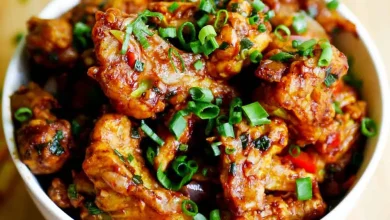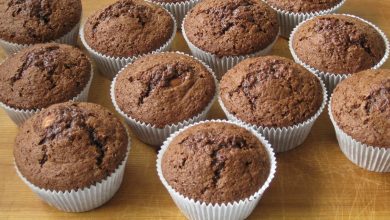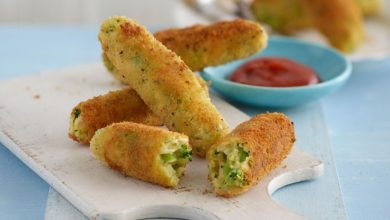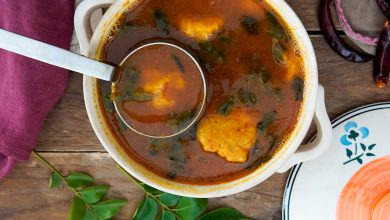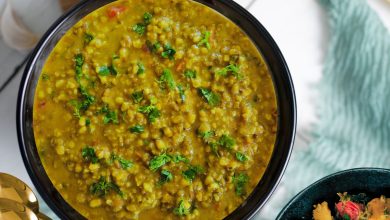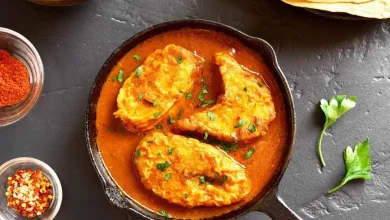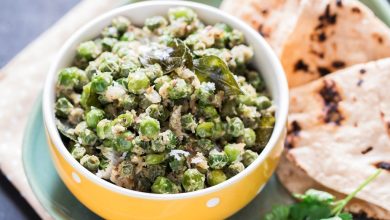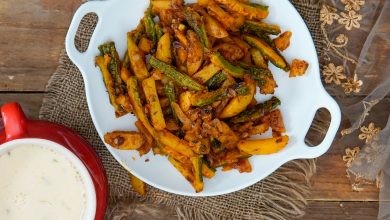Kerala Kanji Payar: Traditional Rice & Moong Dal Delight
Kerala Style Kanji Payar Recipe
Kerala Style Kanji Payar is a comforting and flavorful rice and lentil dish, perfect for a light lunch. This traditional dish from Kerala combines the richness of red matta rice and green moong dal, cooked together with aromatic spices and served with a side of Payar Thoran (stir-fried green gram with grated coconut) and crispy papad. It’s a delicious and wholesome vegetarian meal that’s not only filling but also deeply satisfying.
Ingredients for Kanji Payar
| Ingredient | Quantity |
|---|---|
| Red matta rice | 1 cup |
| Green moong dal (whole) | 1 cup |
| Fresh coconut (grated) | 1/2 cup |
| Garlic cloves | 2 cloves |
| Cumin seeds (Jeera) | 1 teaspoon |
| Green chili (finely chopped) | 1 |
| Turmeric powder (Haldi) | 1 teaspoon |
| Curry leaves | 2 sprigs |
| Salt | To taste |
| Papad | 4 pieces |
Preparation Time: 10 minutes
Cooking Time: 45 minutes
Total Time: 55 minutes
Servings: 2
Cuisine: Kerala
Course: Lunch
Diet: Vegetarian
Instructions
-
Prepare the Rice:
Begin by washing the red matta rice thoroughly. Add the rice and a pinch of salt to a pressure cooker. Pour in 4 cups of water and cook the rice under high pressure for 6-7 whistles. Once the pressure cooker releases its first steam, reduce the heat and let it cook for another 15 minutes. After 15 minutes, turn off the heat and allow the pressure to release naturally. Open the lid and check the consistency of the rice; if needed, add more water to adjust it to a soup-like consistency, as Kanji should be slightly runny.Related Articles -
Cook the Green Moong Dal (Payar Thoran):
In a separate pressure cooker, add the green moong dal (green gram) along with 2 cups of water and some salt. Pressure cook for 4-5 whistles. Once done, turn off the heat and let the pressure release naturally. After opening the cooker, if there is excess water, cook it off until the dal reaches a thick consistency. -
Make the Coconut Mixture:
In a blender, add the grated coconut, garlic cloves, cumin seeds, chopped green chili, and turmeric powder. Blend until the mixture forms a coarse paste. The blend should not be too fine, allowing the coconut and spices to retain some texture. -
Combine the Dal and Coconut Mixture:
Add the freshly blended coconut mixture into the cooked green moong dal, stirring everything well to combine. Throw in the curry leaves and mix them through. Let the dish simmer on low heat for a few more minutes to allow the flavors to meld together. -
Roast the Papad:
While the rice and dal are cooking, roast the papad on a low flame until crispy and golden. You can roast them on an open flame or in a dry pan. Set them aside for serving. -
Assemble and Serve:
To serve, spoon the hot rice kanji into a bowl or plate. For an added touch of richness, drizzle a little ghee (clarified butter) over the rice if you like. Adjust the salt to taste. Serve the Payar Thoran and roasted papad on the side. Enjoy this nutritious and satisfying Kerala dish.
Serving Suggestions
Kerala Style Kanji Payar is traditionally enjoyed with side dishes like Tomato Garlic Chutney, Kerala Vendakka Thoran (Okra Stir Fry), and Elai Vadam (a type of crispy snack). The combination of rice, lentils, coconut, and crispy papad makes it a wholesome and delightful meal, perfect for a light lunch or dinner. You can also pair this dish with a cool glass of buttermilk to complement the spiciness.
Tips for Perfect Kanji Payar
- Consistency: The consistency of Kanji is an important aspect. Adjust the water according to your preference for a thicker or more soupy texture.
- Spices: Adjust the quantity of green chili and cumin seeds to suit your spice level.
- Papad: Roasting the papad on low heat ensures it remains crisp and doesn’t burn.
- Ghee: Adding ghee to the rice is optional, but it enhances the flavor and adds a richness to the dish.
Nutritional Information (Approximate values per serving)
| Nutrient | Amount per Serving |
|---|---|
| Calories | 300 kcal |
| Protein | 9 g |
| Carbohydrates | 50 g |
| Fiber | 7 g |
| Fat | 6 g |
| Sodium | 400 mg |
Conclusion
Kerala Style Kanji Payar is a heartwarming, nutritious dish with rich flavors, combining the earthiness of rice and lentils with the aromatic touch of coconut, cumin, and curry leaves. It is a great representation of Kerala’s rich culinary heritage. Perfect for a light meal or a cozy lunch, this dish will surely transport you to the lush green landscapes of Kerala with every bite. Try it today and enjoy the simple yet powerful flavors of South India!

